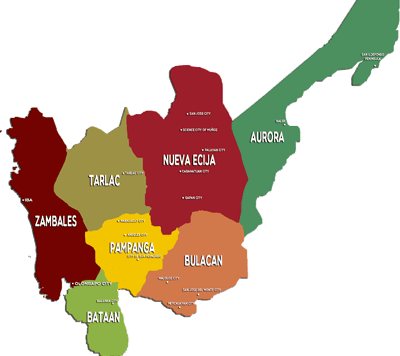Time zone PST (UTC+8) Municipalities 116 | ISO 3166 code PH-03 | |
 | ||
Cities Angeles, Balanga, Bataan, Cabanatuan, Gapan, Mabalacat Points of interest Mount Pinatubo, Mount Samat National, Barasoain Church, Manila Bay, Mount Arayat Destinations Angeles, Subic, Bataan, Subic Bay Freeport, Baler | ||
Region 3 central luzon
Central Luzon (Kapampangan: Kalibudtarang Luzon; Pangasinan: Pegley na Luzon; Ilocano: Tengnga a Luzon; Tagalog: Gitnang Luzon), designated as Region III, is an administrative region in the Philippines, primarily serving to organize the 7 provinces of the vast central plains of the island of Luzon (the largest island), for administrative convenience. The region contains the largest plain in the country and produces most of the country's rice supply, earning itself the nickname "Rice Granary of the Philippines". Its provinces are: Aurora, Bataan, Bulacan, Nueva Ecija, Pampanga, Tarlac and Zambales.
Contents
- Region 3 central luzon
- Map of Central Luzon Philippines
- Overview
- Religion
- Administrative divisions
- References
Map of Central Luzon, Philippines
Overview
Central Luzon Region is located north of Manila, the nation's capital. Bordering it are the regions of Ilocos and Cagayan Valley to the north; National Capital Region, CALABARZON and the waters of Manila Bay to the south; South China Sea to the west; and the Philippine Sea to the east.
There are fourteen cities in the region: Balanga in Bataan; Malolos, Meycauayan and San Jose del Monte in Bulacan; Cabanatuan, Gapan, Muñoz, Palayan and San Jose in Nueva Ecija; Angeles, Mabalacat and San Fernando in Pampanga; Tarlac in Tarlac; and Olongapo in Zambales. Central Luzon produces the most rice in the whole country. Excess rice is delivered and imported to other provinces of the Philippines.
The City of San Fernando, in Pampanga, is designated as the regional center. Aurora was transferred from Region IV through Executive Order No. 103 on May 2002.
Religion
Eighty percent of the population of Central Luzon is Roman Catholic. Other religions represented are Protestants (including Evangelicals), Islam, and Iglesia Ni Cristo. The Members Church of God International (also known by many as Ang Dating Daan) headquarters is located in Apalit, Pampanga where most members are. There are also other denominations such as Jesus Is Lord, Pentecostal Missionary Church of Christ, Jesus Miracle Crusade, United Methodist Church and others.
Administrative divisions
Central Luzon comprises 7 provinces, 2 highly urbanized cities, 12 component cities, 116 municipalities, 3,102 barangays
The Central Luzon Region has fourteen cities. San Jose del Monte is the city with the most population while Angeles is the most densely populated city in the region. Tarlac City is the largest based on land area.
